The first of three Airbus A380 aircraft for Star Alliance carrier All Nippon Airways was rolled out of the paintshop in Hamburg yesterday morning in its special blue ‘turtle’ livery. Japan’s first Airbus A380, it sports a Hawaiian green sea turtle, known as “Honu” in the Hawaiian language, which symbolises good luck and prosperity.
The airline first announced it was ordering just three Airbus A380s in late 2015. A strange decision on the face of it, in fact the trio of superjumbos was part of a deal with the creditors of Skymark Airlines (the major pair being Airbus and Rolls-Royce) to secure more takeoff and landing rights at slot constrained Tokyo Haneda airport, and prevent an American giant encroaching on the Japanese aviation market.
The consequence? Taking these planes was a non-negotiable part of the deal. The result? ANA has triumphed in making the best of an unwanted scenario, branding the ‘FLYING HONU’ jets with unique distinctive liveries and a specialised onboard product and service.
The backstory to the ANA A380
What airline in its right mind orders only three A380s?
Simple question – as it’s clearly impossible to make a profit from a brand new A380 fleet that small due to the significant operational overheads for a standalone wide-body aircraft type.
Simple answer – no airline, not even this one, would ever do it. ANA didn’t order these planes of its own free will. This all happened effectively under duress in 2015 as the carrier was vying for what was left of Japan’s then-bankrupt Skymark Airlines.
ANA needed more slots at Tokyo’s Haneda airport, and Skymark had plenty of them. The problem was that Skymark, in a moment of either misplaced optimism or pure insanity, ordered six brand new Airbus A380s in 2011. These enormous aircraft had a US$1.7 billion value – higher than the airline’s entire 18-strong Boeing 737-800 fleet at the time.
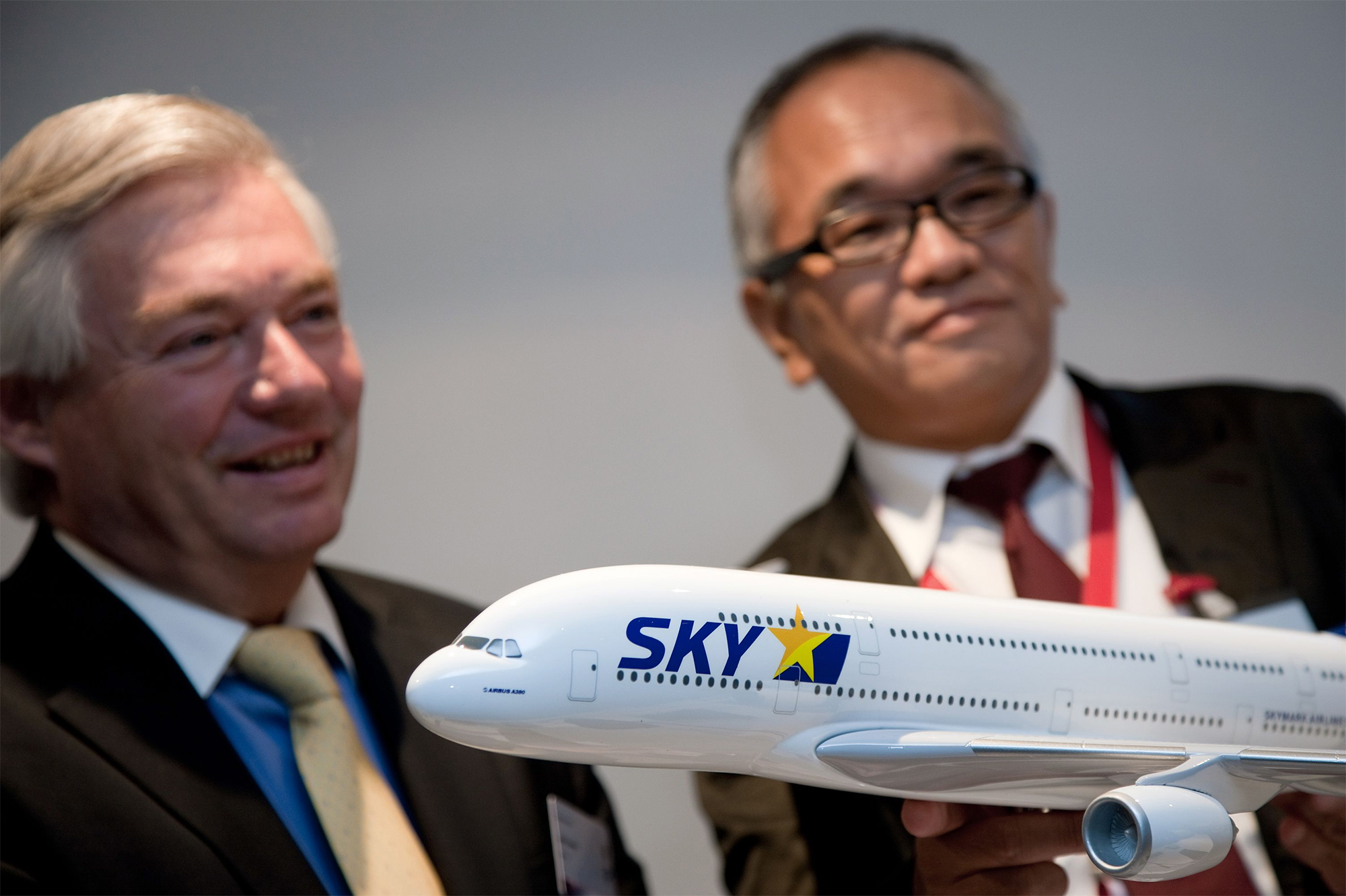
Deposits were paid and Airbus started building the first two planes, but an impasse was soon reached. Skymark, now cash-strapped following a major devaluation of the Yen against the US Dollar, missed a major (and contractually required) payment for the planes in April 2014.
When it became clear later that year that Skymark wouldn’t be able to make the required payments due for the aircraft to be completed, around the time interior fittings including cabins, toilets and galleys were set to be installed, Airbus refused to work on the planes anymore and they were parked up indefinitely.

It was a logical move from the manufacturer – once major service fittings including water and waste lines serving galleys and toilets are installed in an aircraft this size, it’s almost impossible for them to be reconfigured to the preferred specifications of another carrier. In fact no two Airbus A380 operators worldwide have the same galley / toilet locations as one another.
By July 2014, Airbus had run out of patience and formally informed Skymark that its A380 order was terminated. The two aircraft already built were eventually picked up by Emirates in late 2017, though it’s thought Airbus took a large financial hit offloading the pair for around half the list price.
Back to the takeover bidding of the bankrupt carrier though, Airbus (who had now built two A380s for Skymark) and Rolls-Royce (who were building the engines for the planes) were creditors to 45% of Skymark’s debt.

Another complication was that while Jetstar and Hainan Airlines were also in the running to take over the remnants of Skymark, it was US carrier Delta Air Lines who was the most likely viable competition for ANA’s bid.
That meant a potentially catastrophic breakup of the duopoly ANA and JAL enjoyed in the Japanese aviation market.
“Delta has demonstrated its equity investments are not mere tokens; the airline turns its acquisitions into more sustainable operations, integrated into the Delta framework. Delta would likely have made Skymark far more efficient than ANA will ever be able to, as well as generating significant synergies. The threat of a third competitor in the domestic and long haul market was so great as to make any other option preferable. The complexity of an A380 operation, and possibly even of sustaining losses, becomes an acceptable trade-off.” CAPA – January 2016
Unfazed, ANA said it still wouldn’t take the A380s under any deal. Airbus soon let them know who called the shots, with ally Rolls-Royce’s interests well aligned.
“If Skymark submits the plan (that involves ANA’s sponsorship), there is a significant and realistic risk that it would not be able to gain the support of major creditors, including Airbus”. Airbus
In other words, take the planes or Delta wins.
ANA weren’t prepared to let that happen and succumbed to the demand, effectively having to place a fresh order for three brand new A380s as part of the deal. What they were going to do with them was the next question.
“Now ANA must work out where to deploy A380s, not because it wants to, but because it has to.” CAPA – January 2016
The first aircraft
Yesterday morning Airbus rolled out the first ANA Airbus A380 from the paintshop in Hamburg, Germany. Here’s how the ‘whale’ looks, in the blue (green!) turtle livery.

Airbus said that the ANA A380 livery is one of the most elaborate they have ever painted, taking 21 days for the 120-strong team to paint a surface of 3,600 square metres using 16 different shades of colour.
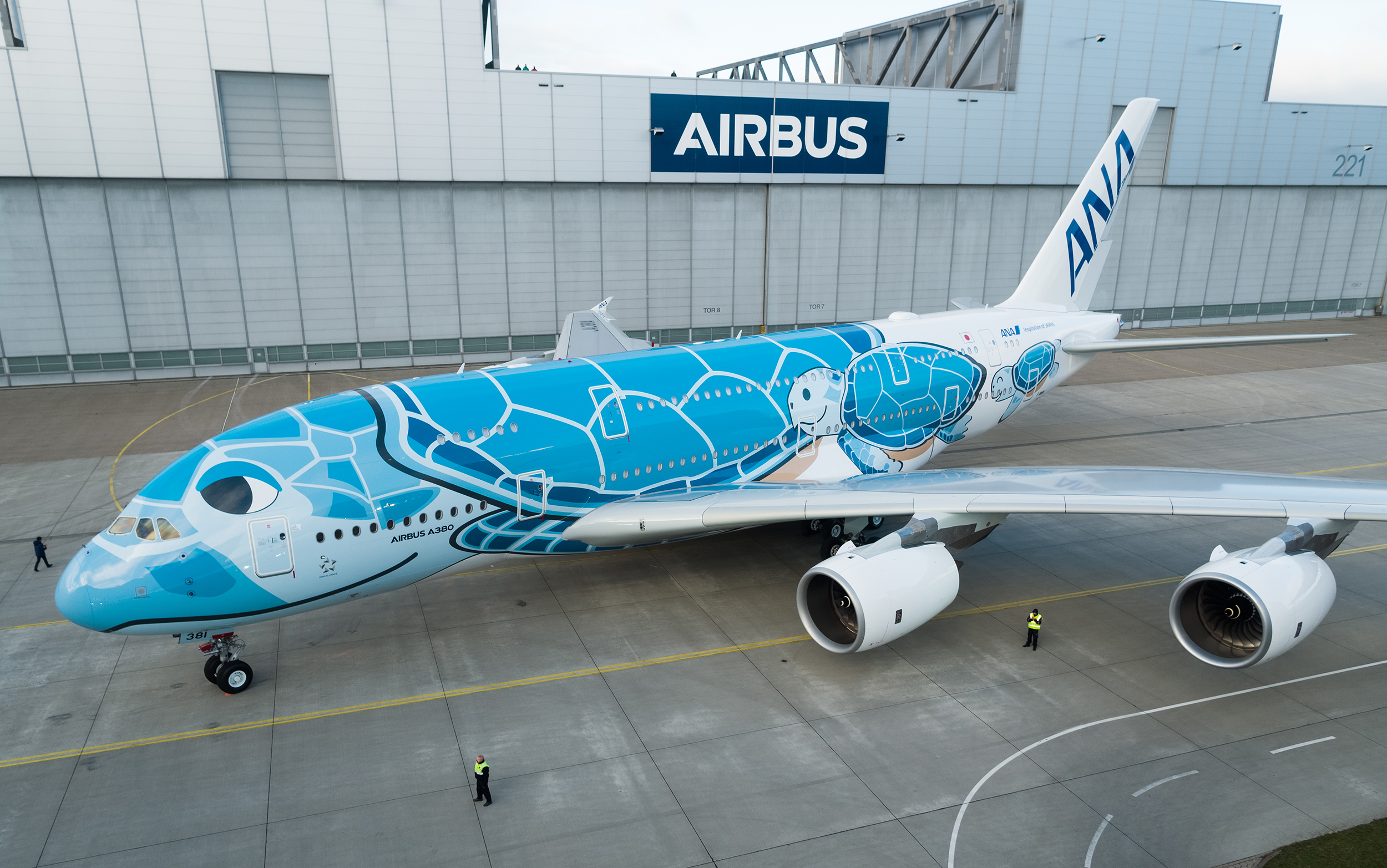
Aircraft two and three will be the green and red versions, arriving from mid-2019.
The aircraft will now have completion of its cabin and enter a final phase of ground and flight tests in Hamburg, before it flies back to Toulouse for preparation of its delivery and ferry flight.
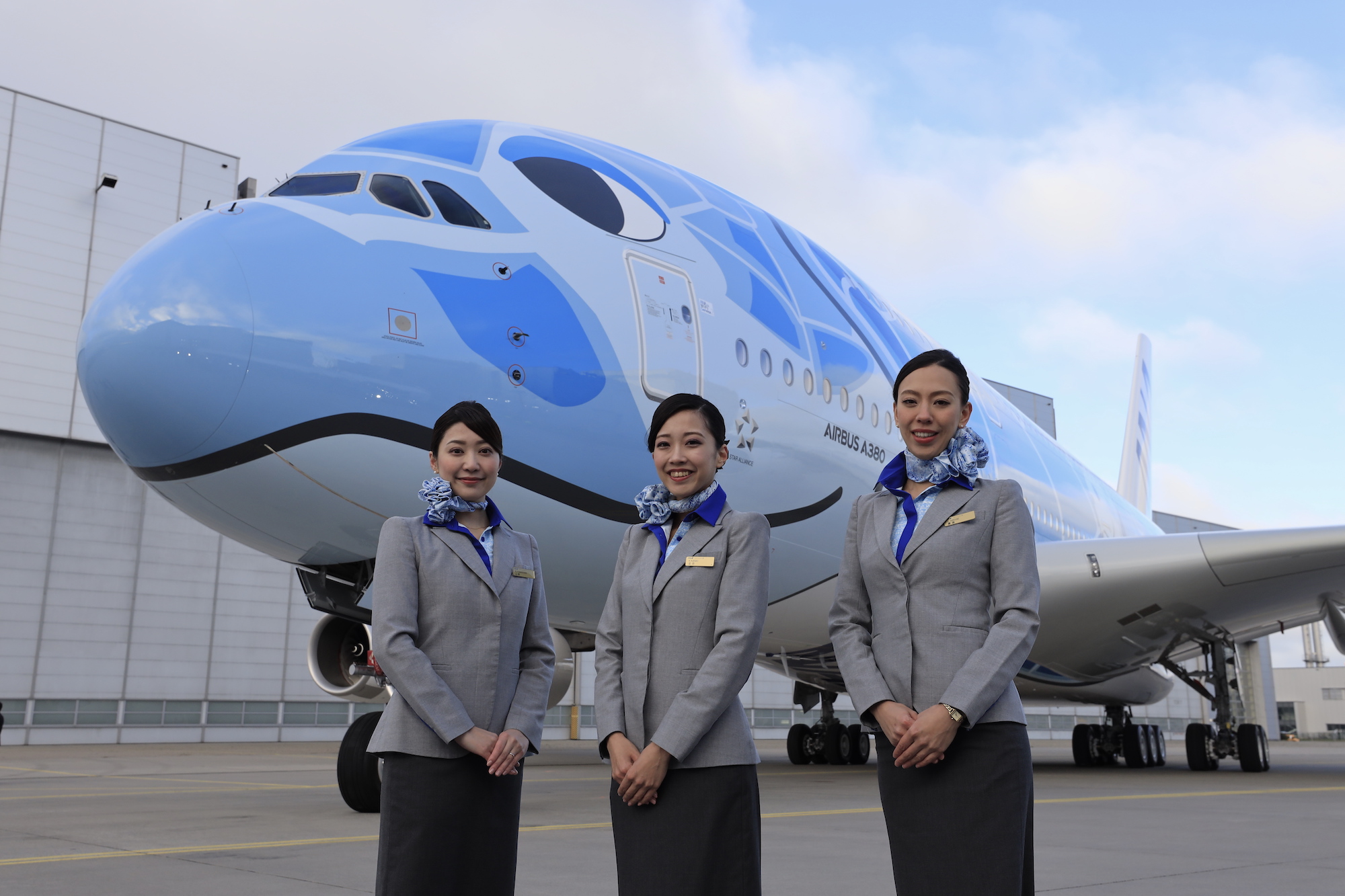
ANA will be the 15th airline worldwide to operate the A380 when it takes delivery in March next year.
Seat map
This will be the second-densest A380 configuration in service once it starts flying next year, with 520 seats in total, comprising:
- 8 First Class Suites
- 56 Business Class Seats
- 73 Premium Economy Seats
- 383 Economy Seats
Only Emirates squeezes more seats into its 2-class A380s, which accomodate an incredible 615 passengers.
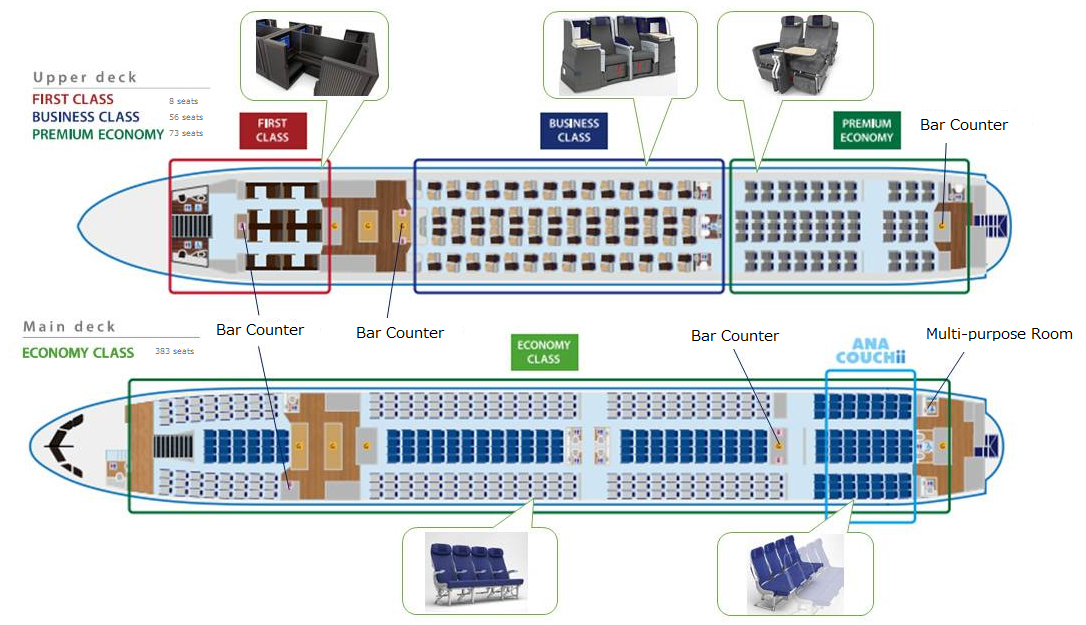
It’s certainly a far cry from Skymark’s original plan to fit just 394 seats to these aircraft – which would have been the lowest density configuration on the market with 114 Business Class seats on the upper deck and 280 Premium Economy seats on the main deck.
First Class
ANA has never offered First Class on its Honolulu route before, so this new 8-seat cabin at the front of the A380’s upper deck, featuring two rows of enclosed suites in a 1-2-1 configuration, is a true enhancement on the route.
Solo window seats are obviously very private, but the central seat pairs have a full-height divider between them in case you don’t know the person next to you, maintaining high privacy levels.
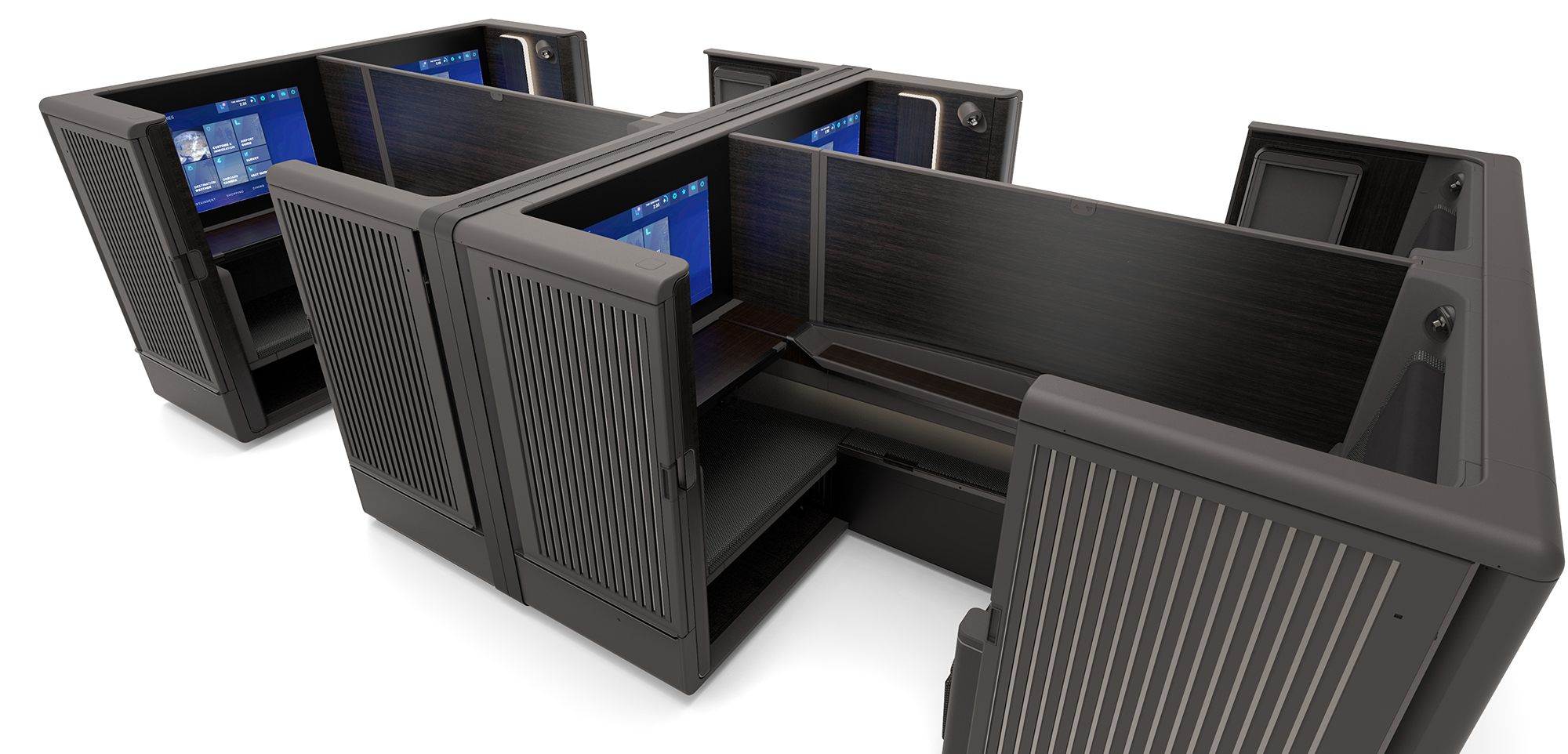
With the divider retracted though, these pairs provide a sociable space for couples with excellent privacy in your ‘double suite’ once the doors are closed at each side.

First Class suite features include:
- Closing doors
- 32″ IFE screen
- A personal linen closet
- Power socket and USB outlets
Amenity kits on the A380 Honolulu flights have been designed in collaboration with English luggage manufacturer Globe-Trotter, the first time the brand has worked with an airline.

When it comes to dining, First Class passengers can look forward to a choice of food from “Noe” an award-winning Italian Restaurant located at the five star luxury Four Seasons Resort Oahu at Ko Olina.
The meal will be overseen by the restaurant’s Michelin starred Head Chef Ryo Takatsuka. This menu will be served from the start of A380 services on 24th May 2019 through the end of August 2019.

When it comes time to take some rest on these 8-hour flights, First Class passengers are provided with a comforter from Japan’s famous Tokyo Nishikawa Sangyo, as with existing First Class ANA flights.
Pillows are made out of premium Hungarian white duck down, and passengers will also receive 100% organic cotton loungewear and a blanket made by the renowned Japanese producer Tenerita, who claim to be the only Japanese company holding the Global Organic Textile Standard certification.
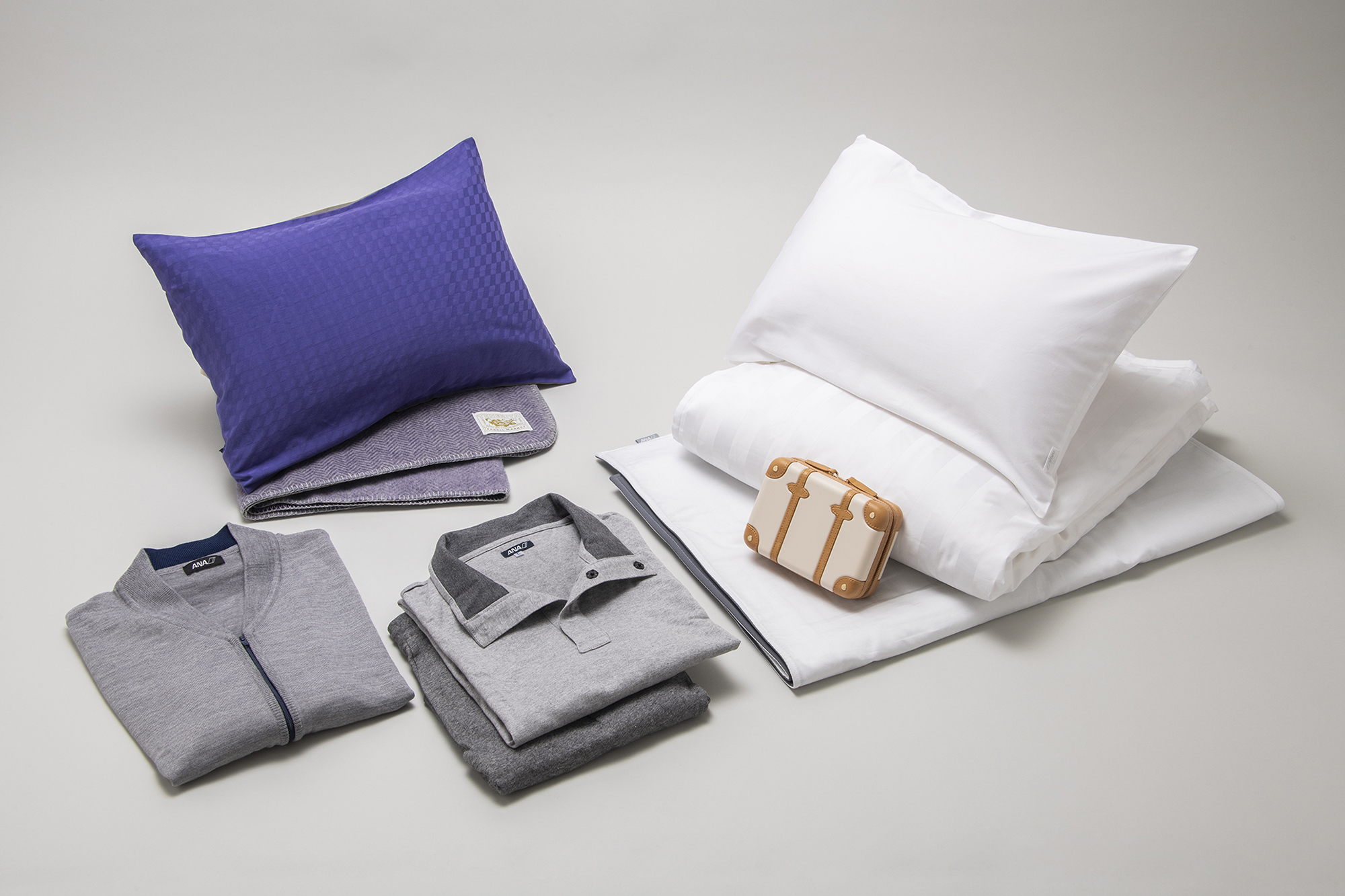
Business Class
In Business Class things start to look a lot more familiar to ANA regulars, with a staggered 1-2-1 configuration in this cabin, however there’s an important difference between the airline’s regular seats found on Boeing 777 and 787 aircraft.
Here there are seven ‘couple’ middle pairs at alternating rows, a strategy ANA has not embraced on other aircraft types, reflecting the leisure demographic of the Hawaii market where many couples will fly together and often find the privacy at each seat of the business cabin on other aircraft a barrier to closeness.

Of course there’s no major cause for concern if you’re flying ‘solo to Hono’ in this cabin, a large privacy divider is in place if you wind up in one of these middle pairs next to a stranger.
The seat features include:
- Direct aisle access
- 18″ touchscreen IFE system
- Power socket and two USB ports
Amenity kits in Business Class on the Honolulu route are from American clothing and accessories brand Fred Segal.

In Business Class, ANA will also be providing sheets, loungewear and a comforter and pillow set from Japan’s Maruhachi Co.
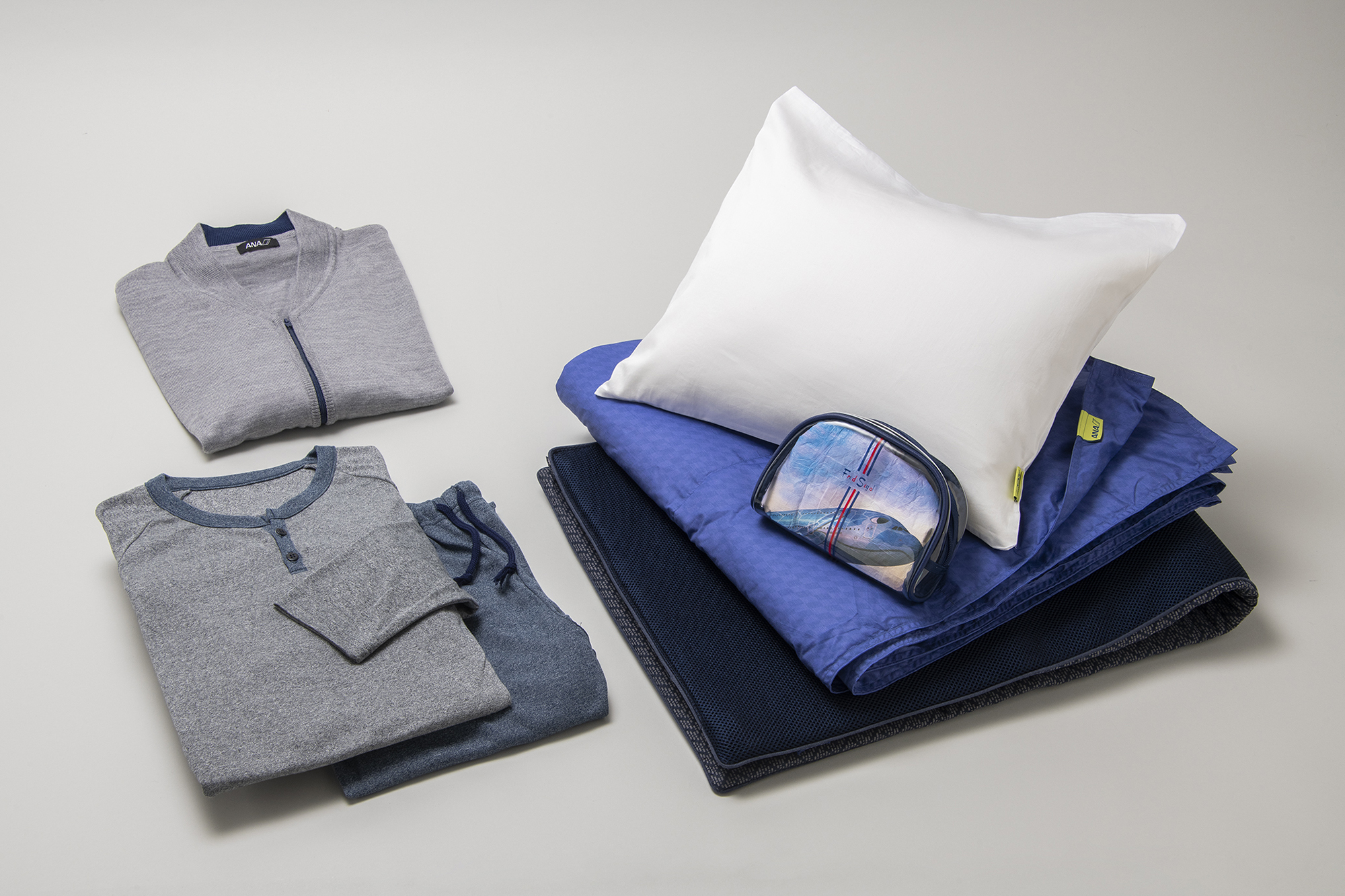
The pillow is designed so that one side is soft and airy, while the other side is more structured so that it provides more neck support.
Of course when it comes to Business Class, ANA has a strong reputation for good catering, especially the Japanese option which is always our favourite.
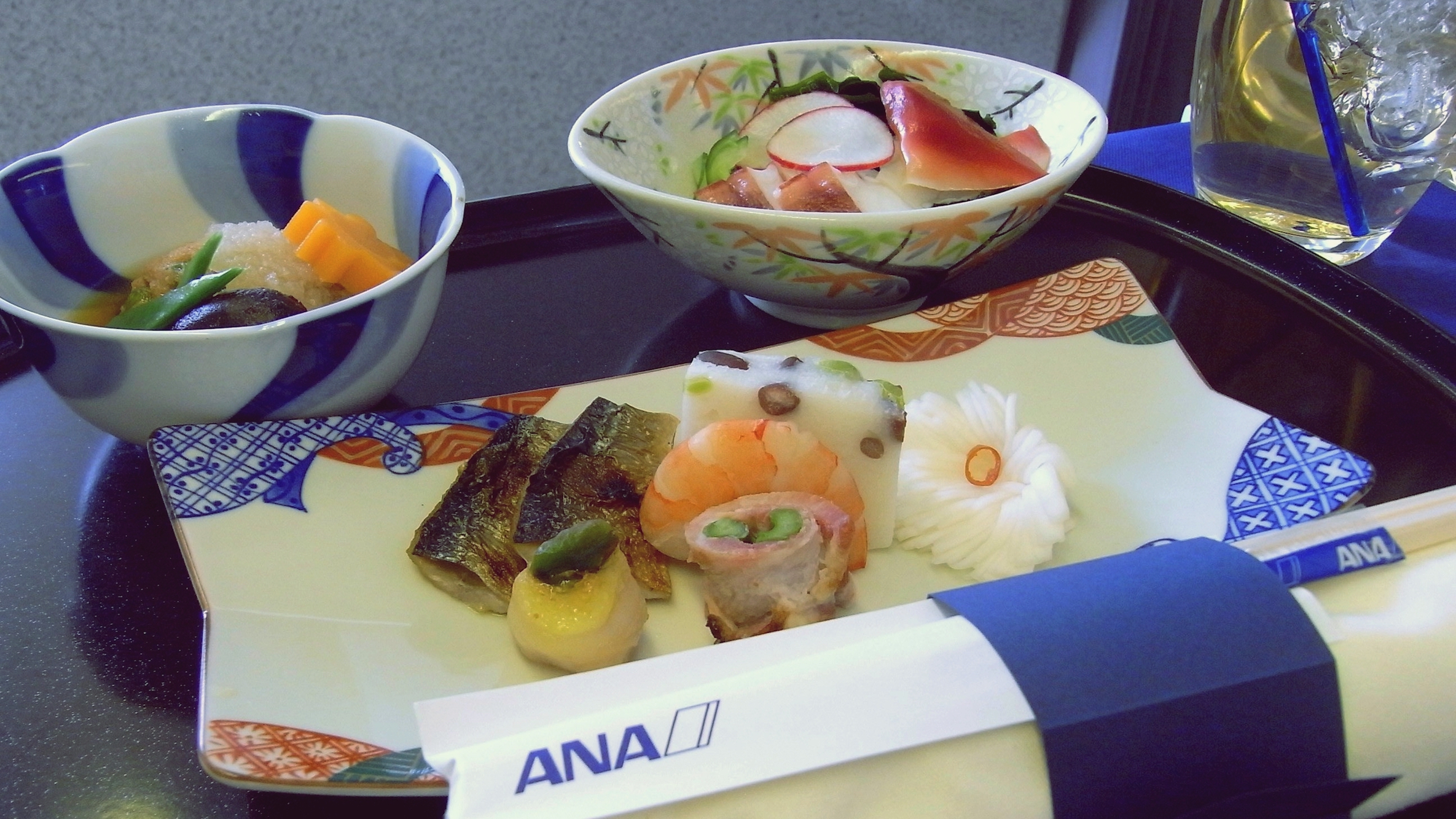
Premium Economy Class
The 73 Premium Economy seats on the ANA A380 are located at the rear section of the upper deck in a 2-3-2 configuration.
These seats benefit from:
- 38″ seat pitch
- 15.6″ touchscreen IFE system
- Headrest and leg rest adjustable in six dimensions
- Adjustable reading light
- Power socket and USB port

Passengers traveling Premium Economy will receive a FLYING HONU beach bag from Tyvek.
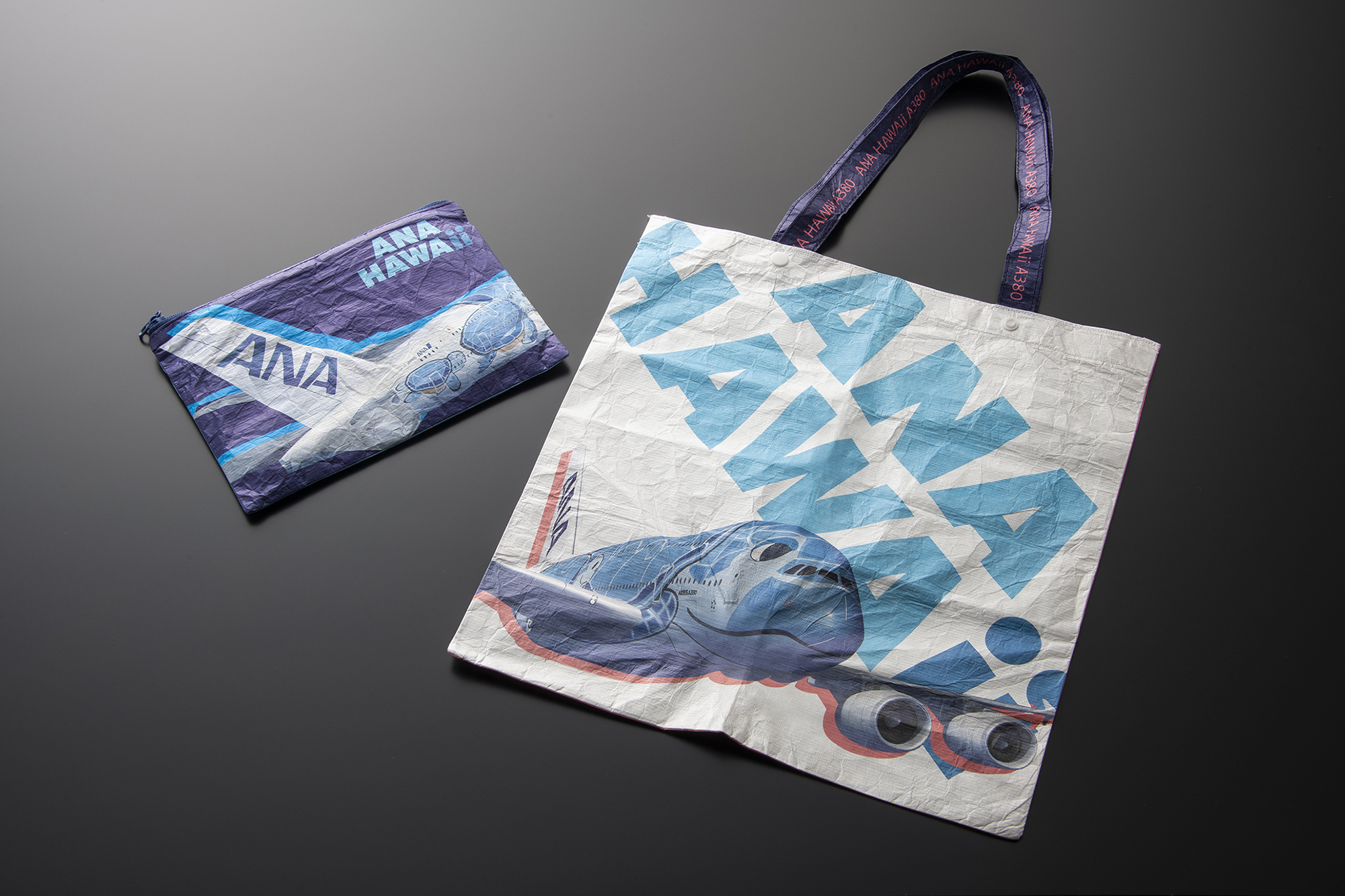
ANA is also upgrading meals for Premium Economy flyers, for the first time offering them a superior menu in comparison to the one served in Economy Class. As before, a choice from both International and Japanese culinary traditions will be available.
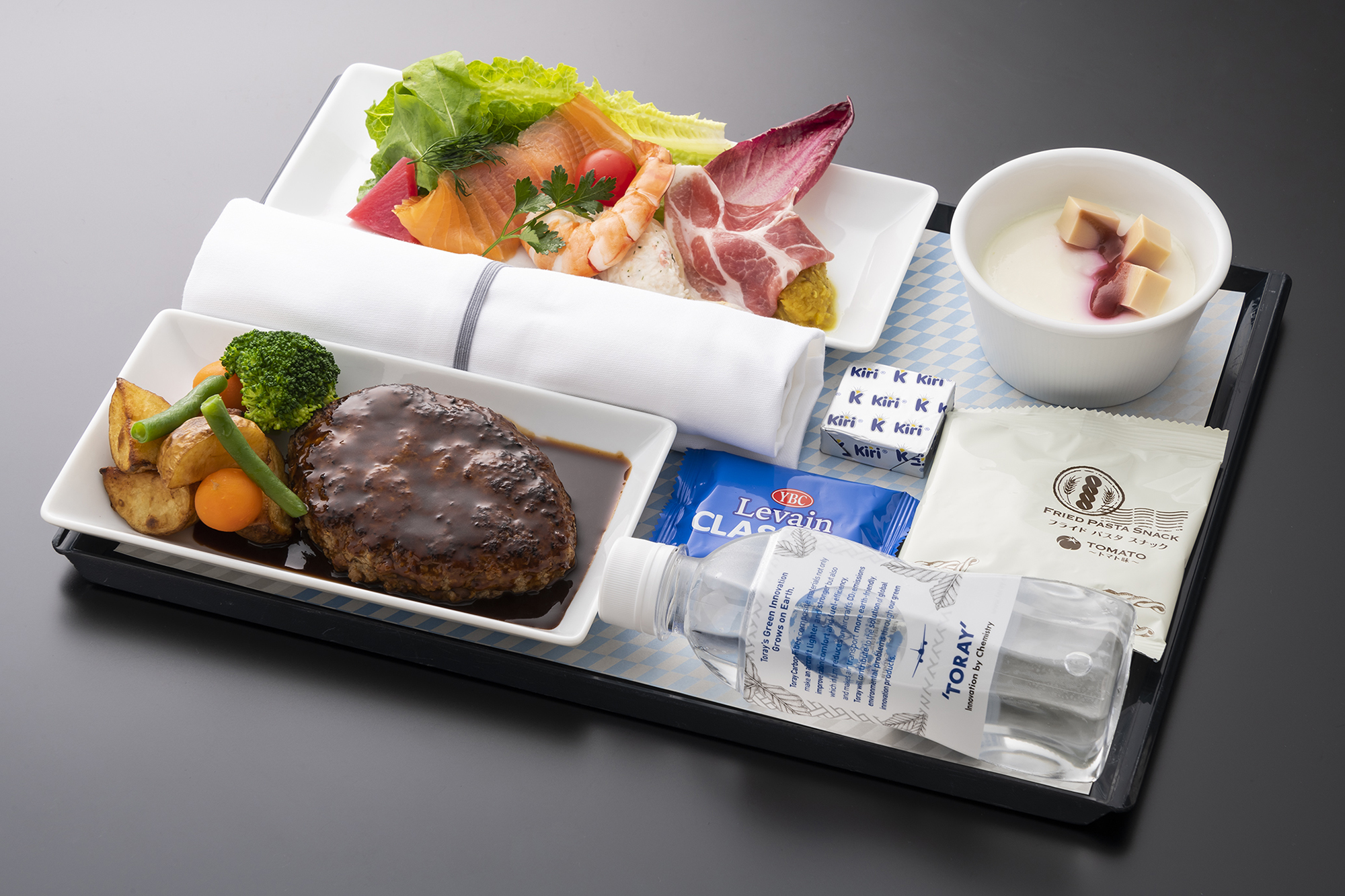

Economy Class
In economy, which occupies the entire main deck of the aircraft in a 3-4-3 layout, you’ll find the relatively standard ANA economy seat offering:
- 34″ seat pitch
- 13.3″ touchscreen IFE system
- Headrest and leg rest adjustable in six dimensions
- Power socket and USB port

At the very back the last 7 rows have economy seats with a reduced 32″ pitch but which can be converted to ‘couch seats’ a bit like the Air New Zealand Economy Skycouch™. The ANA versions will be called ‘ANACOUCHii’.
Here’s what ANA says about it:
“Each couch is comprised of three or four seats and passengers are able to lie on the seats by folding up the leg rests. In addition, passengers will receive a dedicated mattress that will provide them with further comfort. This new seat concept will especially enable passengers traveling with small children to have a more relaxed experience in the cabin.”
And here’s how it will look:

Passengers traveling on ANA COUCHii, will have a dedicated bed sheet, pillow and blanket set.
Other features
ANA’s A380s will also be equipped with some additional features and services, including:
- A drink and snack bar that passengers can visit at any time throughout the flight.
- Exclusive complimentary blue Hawaii cocktails that match the airplane’s FLYING HONU theme, available in all classes.
- Drinks onboard served in FLYING HONU themed cups, by flight attendants wearing similarly designed aprons.
- Enhanced services for children including specialty-branded silverware from “EDISONmama”, ANA original bags and inflatable FLYING HONU toys.
- A new flight map called “ANA Flight Path 3D”. This will allow passengers to see the aircraft from various angles as well as the actual perspective from the cockpit (though we don’t think a live camera feed is included).
Further aircraft
Two more ANA Airbus A380s are set for delivery and will feature two more special turtle liveries in emerald green and orange respectively.

Service entry
The first aircraft is set for delivery to ANA in March 2019, with flights to Honolulu three days per week from 24th May 2019, departing from Tokyo on Tuesdays, Fridays and Sundays.
Frequency increases to 10 flights per week from 1st June 2019, once the second aircraft is delivered. That means double daily A380 operation from Tokyo on Tuesdays, Fridays and Sundays, with a single flight on other days.
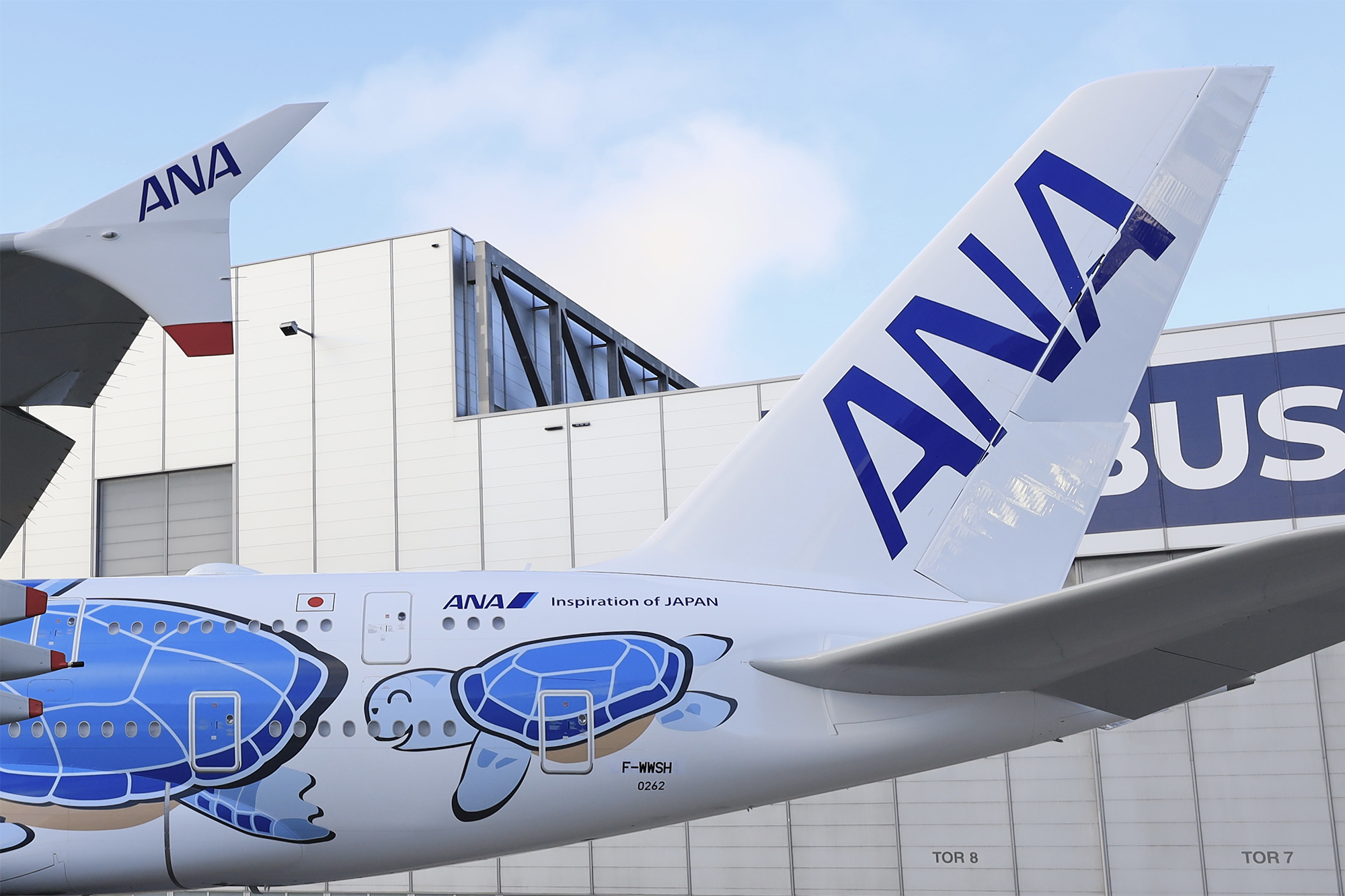
Exact flight schedules and plans for the third aircraft have not yet been revealed, but we believe these flights will simply progressively replace the year-round double daily Boeing 787-9 flights currently flying between Tokyo Narita and Honolulu.
Redemption rates
Here are the miles redemption options we expect you will be able to take advantage of once flight timetables for these new flights are loaded. Firstly, all the way from Singapore to Honolulu via Tokyo.
| ANA redemption Singapore – Honolulu via Tokyo Narita | |||
| FFP used | Economy | Business | First |
| 55,000 | 97,500 | 135,000 | |
| 30,000* | 50,000* | 90,000* | |
| 30,000 | 52,000 | 85,000 | |
| 40,000 | 55,000 | 75,000 | |
| 35,000 | 65,000 | 80,000 | |
| 30,000 | 51,000 | 75,000 | |
| 55,000 | 97,500 | 145,000 | |
* ANA Mileage Club requires all redemption flights to be return journeys, the mileage shown here is half the total for a return trip for proper comparison with other FFPs, but there is no option to actually book one-way under ANA Mileage Club.
Secondly if you just want to redeem from Tokyo to Honolulu.
| ANA redemption Tokyo – Honolulu | |||
| FFP used | Economy | Business | First |
| 54,000 | 105,000 | 125,000 | |
| 20,000* | 32,500* | 62,500* | |
| 20,000 | 35,000 | 62,500 | |
| 40,000 | 55,000 | 75,000 | |
| 27,500 | 55,000 | 85,000 | |
| 27,500 | 48,000 | 66,000 | |
| 50,000 | 92,500 | 145,000 | |
* ANA Mileage Club requires all redemption flights to be return journeys, the mileage shown here is half the total for a return trip for proper comparison with other FFPs, but there is no option to actually book one-way under ANA Mileage Club.
As you can see the Singapore Airlines KrisFlyer Star Alliance award comes out pretty poorly in comparison to some other frequent flyer programs, especially Lifemiles, Miles & More, Miles + Bonus and MileagePlus.
We’re hoping for good redemption availability especially in the large business class cabin with 56 seats, and we’ll be keeping an eye on this when A380 tickets formally go on sale.
We love Hawaii and so we’re looking forward to trying out the new planes, perhaps next year, and hopefully in those coveted First Class suites if we can.
Summary
Kudos to ANA for going all out on this A380 project. They never wanted these three planes, a chain around their neck as part of the Skymark Airlines rescue plan.
ANA could have just painted these jets in its standard livery and shipped them off on daily flights to London, New York or Los Angeles.
Theming the aircraft, their whole operation and investing heavily in a dedicated onboard product across the four cabin classes is fantastic dedication to a project which is unlikely to ever return a profit, no matter how much ANA manage to charge for tickets on the popular Japan – Hawaii flights.

Airbus won’t be too happy with this reveal either, despite the media fasciation. The A380 was supposed to be the iconic ‘hub to major city’ capacity-busting flagship product in an airline’s fleet, not a high-density aircraft serving leisure markets.
Flag carriers in neighbouring Asian countries are unlikely to be buoyed by ANA’s rejection of any longstanding business route for these planes, such as London or New York.
Drumming up further orders for A380s from the Asia-Pacific region remains a tough sell for Airbus.
(Cover Photo: Airbus)
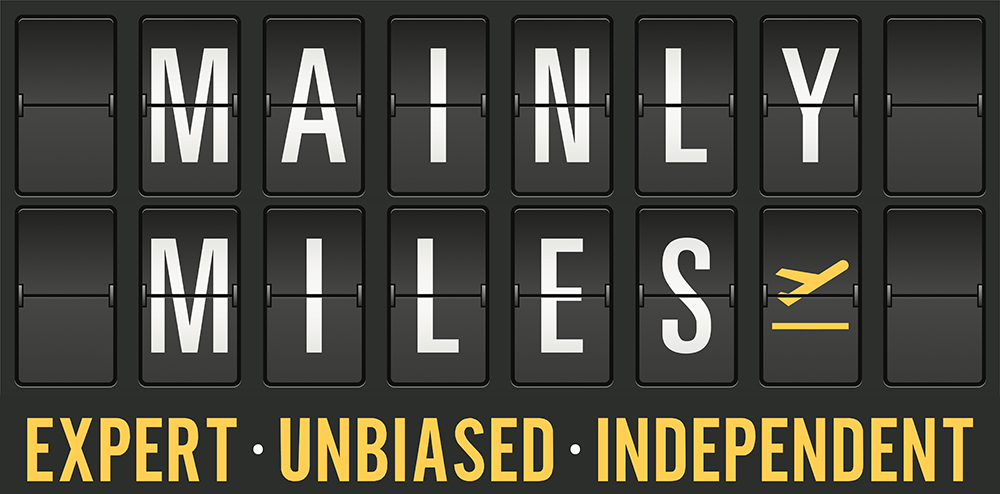



Hi Andrew, nice write up! you should really get a raise from Aaron or at least a nice Xmas dinner.
Do you all think when they start selling the couch seats, would it be available to anyone (e.g. 2 person who is willing to pay for price of 4 seats so that you can form the couch) or only to passenger with children? Thank you.